

Search results for mobile. In the first article in this ‘Alice’ series I focused on the changing world of work and the evidence that workplace learning is usually more effective and efficient than formal learning.
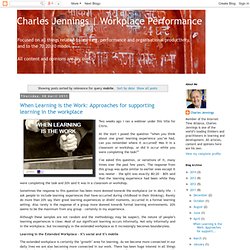
I also spoke of the need for learning departments to ‘join the dance’ (like the lobster in Alice) and develop new skills and capabilities so they can incorporate learning outside classrooms into their armoury, along with the development of structured learning. In this article I want to turn to the ‘how’ of change and transformation in organisational learning and look at one specific approach that many organisations are finding useful to help them adapt to meet changing requirements and demands – the 70:20:10 framework.
As with the first article, I’m going to call on some insights from Mr Charles Dodgson (Lewis Carroll) for some help. Who Stole The Tarts? Alice had never been in a court of justice before, but she had read about them in books. Mobile Learning or Performance Support ? (#mlearning) Although organizations desire to leverage mobile technologies to train employees, and education institutes want to engage learners and improve learning outcomes through the devices in their pockets.
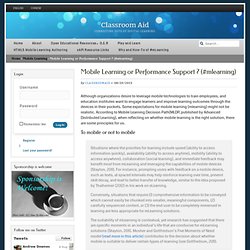
Some expectations for mobile learning (mlearning) might not be realistic. According to Mobile Learning Decision Path(MLDP, published by Advanced Distributed Learning), when reflecting on whether mobile learning is the right solution, there are some principles for us. To mobile or not to mobile Situations where the priorities for learning include speed (ability to access information quickly), availability (ability to access anytime), mobility (ability to access anywhere), collaboration (social learning), and immediate feedback may benefit most from mLearning and leveraging the capabilities of mobile devices (Stayton, 2011). Furthermore, if you answer yes to one of the following questions, that means you need a performance support solution, not normal mobile learning or training solution.
Mobile and Performance Support: Learning & Skills 2013. John Helmer reports from the Learning and Skills Group Conference and Learning Technologies Summer Forum.
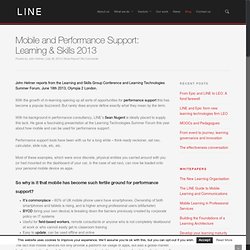
June 18th 2013, Olympia 2 London. With the growth of m-learning opening up all sorts of opportunities for performance support this has become a popular buzzword. But rarely does anyone define exactly what they mean by the term. With his background in performance consultancy, LINE’s Sean Nugent is ideally placed to supply this lack. When do we need performance support? With performance support being such a hot topic in the world of learning technologies right now, there is a very important question that needs answering: when do we need performance support?

In Imogen Casebourne and Rhodri Jones’ performance support insight, the ‘Five Moments of Need’ is addressed. The Five Moments of Need were devised by Ontuitive’s Conrad Gottfredson and Bob Mosher, and aim to show us when we might need help in the workplace. Here, we will take a look at some common scenarios related to each of these five moments. 1. When learning something for the first time If you are starting an entirely new job in a new industry, it is inevitable that you will come across challenges you can’t always figure out for yourself. 2. As the latest Towards Maturity Benchmark revealed, lots of us turn to Google when we’re looking for more information. The Five Moments of Need Acquisition of KnowledgeT. 5 Reasons Why Performance Support & Mobile Is A Match Made In Heaven! Mobile Performance Support (PS): There's an App for That! Why 2013 is the Year for Performance Support These days it seems we don't go anywhere without a mobile connection of some kind.

Smartphones and now tablets are just part of our daily existence, allowing us to stay connected wherever we are. No one who’s seriously gone mobile should be surprised to hear that the mobile workforce is growing. It’s huge! A recent IDC report says that this year, the number of mobile workers will total 1.3 billion around the world-- an impressive 37.2% of the workforce. We live in a time, according to renowned surgeon, Atul Gawande, author of The Checklist Manifesto, when, “The volume and complexity of what we know has exceeded our individual ability to deliver its benefits correctly, safely, or reliably.” So, in our "consumer" life, we get it.
Blended Learning and Mobile Performance Support. “We can’t keep thinking of training as a one-time event.”
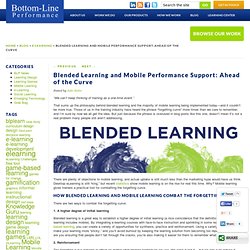
That sums up the philosophy behind blended learning and the majority of mobile learning being implemented today—and it couldn’t be more true. Those of us in the training industry have heard the phrase “forgetting curve” more times than we care to remember, and I’m sure by now we all get the idea. But just because the phrase is overused in blog posts like this one, doesn’t mean it’s not a real problem many people still aren’t addressing. Better Together: Mobile Learning and Performance Support. Mobile for Learning and Performance Support - Mobile Experts - WorkLearnMobile. Why WorkLearnMobile asked Allison.
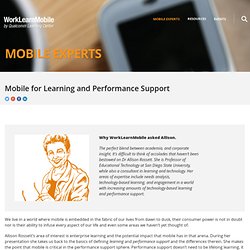
The perfect blend between academia, and corporate insight. Ode to Mobile Performance Support by Allison Rossett. “One of the great things about the humble print job aid is that it goes where it is needed.
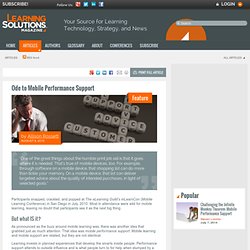
That’s true of mobile devices, too. For example, through software on a mobile device, that shopping list can do more than tickle your memory. On a mobile device, that list can deliver targeted advice about the quality of intended purchases, in light of selected goals.” Participants snapped, crackled, and popped at The eLearning Guild’s mLearnCon (Mobile Learning Conference) in San Diego in July, 2010. Advanced Distributed Learning. Mobile learning should NOT be merely viewed as a replacement, an alternative, or as a new addition to existing training delivery methods.
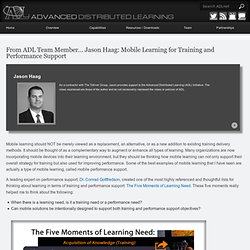
It should be thought of as a complementary way to augment or enhance all types of learning. Many organizations are now incorporating mobile devices into their learning environment, but they should be thinking how mobile learning can not only support their overall strategy for training but also used for improving performance. eLearning Guild Research: Mobile Learning for Supporting Workers' Performance by Patti Shank. “If you think about it, providing essential knowledge at the moment it is most needed is the best we can do as learning professionals.
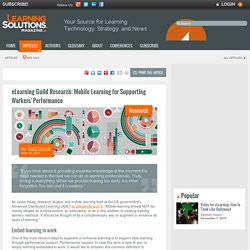
Truly, timing is everything. When we provide training too early, it is often forgotten. Too late and it is useless.” As Jason Haag, research analyst and mobile learning lead at the US government’s Advanced Distributed Learning (ADL) so eloquently puts it, “Mobile learning should NOT be merely viewed as a replacement, an alternative, or as a new addition to existing training delivery methods. “What We Got Here Is … an EPSS” by Conrad Gottfredson. In Donn Pearce’s book Cool Hand Luke, each time the captain of Road Prison 36 recaptures Luke he says to him, “What we got here is ... a failure to communicate.” And this just may well be the case now with our conversations around performance support (PS) and its range of incarnations. To begin, here are three critical clarifications: